You can make contactless payments directly from your wrist using Fitbit Pay, which works on compatible devices like the Charge 4, Charge 5, Charge 6, Sense, Sense 2, Versa 2, Versa 3, and Versa 4. Simply add up to five credit or debit cards to your Fitbit Wallet, set up a 4-digit PIN for security, and hold your device near any contactless payment terminal. The feature works even when swimming thanks to water-resistant designs, though Google Wallet will replace Fitbit Pay starting January 2025. Discover which models offer the best payment experience below.
What Is Fitbit Pay and How Does It Work
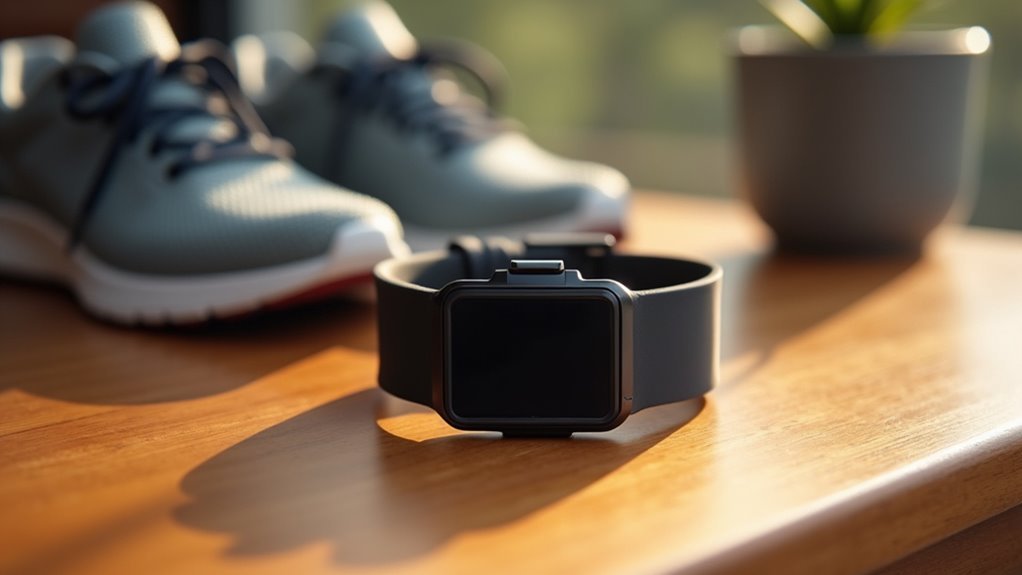
Convenience meets cutting-edge technology with Fitbit Pay, a mobile payment platform that transforms your fitness tracker into a digital wallet.
Transform your wrist into a digital wallet with Fitbit Pay’s seamless blend of fitness tracking and contactless payment technology.
You’ll need a Fitbit device equipped with an NFC chip to make contactless payments directly from your wrist.
The system stores digital versions of your credit or debit cards in the Fitbit Wallet through the smartphone app. Once you’ve linked your cards to your device, you can tap your Fitbit against any contactless payment terminal to complete transactions.
You’ll need to enter a PIN for security, which stays active for 24 hours or until you remove your device.
Most banks support this payment method, making it widely accessible for everyday purchases at stores, restaurants, and transportation systems. You’ll earn the same rewards and points with Fitbit Pay as you would when using your physical credit or debit card.
Compatible Fitbit Devices for Contactless Payments
Several Fitbit models support contactless payments, but you’ll need to guarantee your device includes an NFC chip to access this functionality.
Compatible models include Fitbit Charge 3 (NFC editions only), Charge 4, Charge 5, and Charge 6. The Fitbit Sense and Sense 2 also feature built-in NFC capabilities. Additionally, Versa 2, Versa 3, and Versa 4 support contactless payments through their NFC hardware.
It’s important to note that only certain Charge 3 editions include the required NFC chip, while newer models have this technology built-in.
Starting January 13, 2025, Google Wallet will replace Fitbit Pay on these devices. You’ll need to update your Fitbit app to version 4.27 or higher to set up Google Wallet and continue using contactless payment features seamlessly. Google Wallet offers an increased number of banks and cards available for contactless payments compared to the previous Fitbit Pay system.
Setting Up Fitbit Pay on Your Device
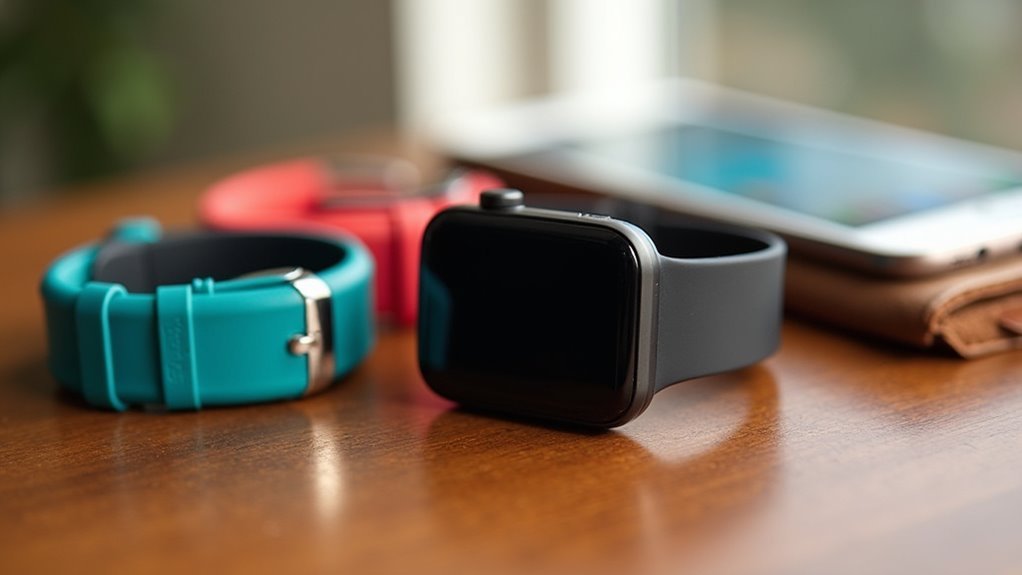
Setting up Fitbit Pay on your compatible device requires adding payment cards and configuring security features to protect your financial information.
You’ll need to enter your card details through the Fitbit app’s Wallet feature and create a 4-digit PIN for your tracker.
The setup process also involves verifying your identity with your card issuer and ensuring your smartphone has proper authentication enabled. Your payment information is protected through industry-standard tokenization for enhanced security during transactions.
Adding Payment Cards
Before you can tap your Fitbit to pay for purchases, you’ll need to add at least one payment card to your device’s digital wallet. Open the Fitbit app, navigate to the Today tab, and tap your profile picture. Select your device tile, then tap the Wallet option.
| Step | Action | Details |
|---|---|---|
| 1 | Card Entry | Manual input or camera scan |
| 2 | Security Code | Enter CVC for verification |
| 3 | Identity Check | Choose text, email, or call |
| 4 | Confirmation | Enter verification code |
You can add up to five cards from participating banks. Complete identity verification when prompted, and your bank may require additional security steps. Once verified, set your default card and make sure your device’s four-digit PIN is ready for secure payments. For enhanced security, your card numbers are not stored on the device or Fitbit servers during this process.
Device Authentication Setup
Once you’ve added your payment cards, you’ll need to set up device authentication to secure your Fitbit Pay transactions.
During initial Fitbit Pay configuration, you’ll be prompted to create a unique 4-digit PIN code. You must enter and verify this PIN to confirm setup.
If your device’s passcode protection is disabled, the setup will prompt you to re-enable it since this protection is mandatory for Fitbit Pay to function properly.
Your sensitive payment data gets encrypted and stored securely on the device. Make sure Bluetooth is enabled and your device is nearby during the setup process.
Once you’ve completed authentication setup, you can’t alter these settings without re-authentication for security reasons.
Supported Banks and Financial Institutions
Most major credit and debit cards work with Fitbit Pay, though support varies by region and card network. You’ll find Visa and Mastercard accepted globally, while American Express works only in the US. However, there’s a significant alteration coming—Fitbit Pay is being phased out starting January 13, 2025, in favor of Google Wallet on compatible devices.
| Region | Bank | Card Type |
|---|---|---|
| US | Bank of America | Visa/Mastercard |
| US | Chase Bank | Visa |
| US | American Express | Amex |
| UK | Revolut | Mastercard |
| UK | Starling Bank | Mastercard |
The shift to Google Wallet won’t necessarily retain all previous banking support. You’ll need to verify your specific bank’s compatibility with Google Wallet for Fitbit devices before the change occurs. If you encounter issues with card compatibility, consider joining the Community Forums where users share experiences and troubleshooting solutions for payment-related problems.
Security Features and Data Protection
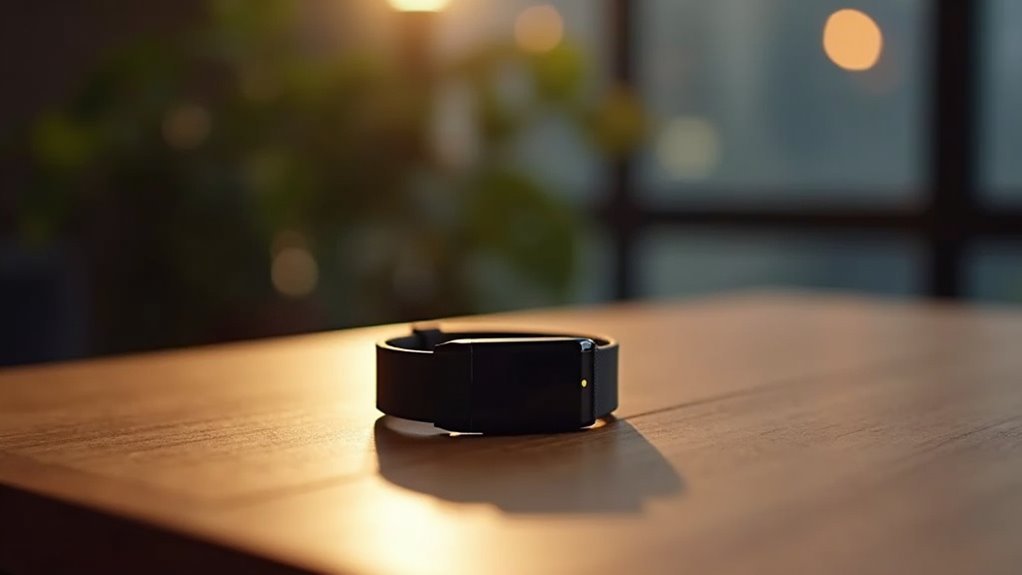
While banking compatibility matters for accessing Fitbit Pay, the platform’s robust security architecture protects your financial data once you’re set up.
Fitbit Pay employs industry-standard tokenization to guarantee your card information never reaches merchants or Fitbit itself.
Your security layers include:
- Tokenization protection – Your actual card numbers aren’t stored or transmitted during transactions
- 4-digit PIN requirement – You’ll need your personal PIN code for every payment
- Encrypted data transmission – All verification information gets encrypted before network approval
- Limited data storage – Only your card’s last four digits display on your device
- Fraud protection coverage – Your financial institution’s fraud protection applies to all transactions
The system includes an automatic device lock feature that prompts for your PIN whenever you remove the tracker from your wrist.
You’ll maintain complete control over your data through privacy settings, and Fitbit doesn’t store transaction history.
Making Your First Contactless Payment
You’ll need to set up your payment cards through the Fitbit app before making your first contactless transaction.
The process requires bank verification and authentication to guarantee your card details are securely loaded into your device’s wallet.
Once setup’s complete, you can tap your Fitbit at any contactless-enabled payment terminal to complete purchases instantly. Look for approval confirmation through a green light, beep sound, or checkmark displayed on the terminal screen.
Setup Payment Cards
Getting your Fitbit ready for contactless payments starts with setting up your payment cards through the Fitbit app.
You’ll need to access the Today tab, select your Fitbit device, and tap the Wallet tile to begin the process.
Adding payment cards is straightforward:
- Scan or enter card details – Use your phone’s camera to scan your credit or debit card, or manually input the information.
- Enter security code – Provide your card’s 3-digit security code for verification.
- Complete bank verification – Your bank may contact you via text, email, or phone call to confirm the addition.
- Set default card – Choose which card you want as your primary payment method.
- Add multiple cards – You can store up to 5 payment cards in your Fitbit Wallet.
Authentication Before Transaction
Before you can tap and pay with your Fitbit, you’ll need to authenticate yourself through a security setup process.
First, confirm your device has passcode protection enabled – this is mandatory for Fitbit Pay functionality. You’ll then need to set up a 4-digit PIN code that you’ll enter before each transaction.
When making your first payment, swipe down from your device’s top screen to access Fitbit Pay. Select your preferred payment card from your wallet, then hold your Fitbit near the contactless payment terminal.
Enter your PIN code to authenticate the transaction. Some banks may require additional verification steps during initial setup, which could include SMS verification codes. If you don’t receive the verification code, you may need to contact your cell service provider to enable short code messaging.
Enable notifications to complete the setup process and confirm smooth future transactions.
Complete Payment Process
With your PIN set up and security measures in place, making your first contactless payment becomes straightforward.
You’ll open the Fitbit Wallet app on your device and select your preferred card if you’re not using the default option.
- Hold your wrist close to the contactless payment reader until you feel a vibration
- Wait for the payment confirmation to appear on your device screen
- Select “Credit” on the terminal if using a debit card to avoid PIN entry
- Reposition your device closer if the reader doesn’t recognize it initially
- Switch cards directly on your Fitbit before tapping if paying with a different card
The entire process takes seconds, utilizing tokenized card data for enhanced security while keeping checkout times minimal.
Fitbit Pay Vs Competitor Payment Solutions
While Fitbit Pay offers solid payment functionality for fitness enthusiasts, it faces stiff competition from tech giants who’ve invested heavily in mobile payment ecosystems.
Apple Pay dominates with superior biometric authentication through FaceID and TouchID, plus Daily Cash rewards offering up to 3% cashback. You’ll find Apple Pay works seamlessly across apps and web transactions, while Fitbit Pay focuses primarily on in-person NFC payments. Apple Pay utilizes tokenization technology to store a unique device account number in the Secure Element chip, ensuring actual card numbers are never shared with merchants.
Apple Pay’s biometric security and cashback rewards create a comprehensive payment experience that extends far beyond Fitbit’s fitness-focused approach.
Google Pay provides extensive features including peer-to-peer transfers and merchant loyalty programs. Samsung Pay offers ample rewards through their dedicated app.
However, Fitbit Pay’s advantage lies in fitness-focused integration and device lock security features. While competitors offer broader payment ecosystems, Fitbit Pay excels for users prioritizing fitness tracking with convenient payment capabilities rather than extensive financial services.
Global Availability and Regional Limitations
Fitbit Pay’s global reach has undergone a significant transformation as Google shifts the service to Google Wallet across most regions.
Starting July 29, 2024, the change affected most countries, though Saudi Arabia, Japan, and Taiwan initially remained on legacy Fitbit Pay until complete phaseout by January 2025.
Your payment experience depends on several regional factors:
- Device compatibility – Newer Fitbit models (Versa 4, Sense 2, Charge 6) default to Google Wallet
- Bank partnerships – Local financial institutions must support the service in your country
- Card brand acceptance – Visa and Mastercard work globally, while Amex is US-only
- Transit system integration – Limited to cities with compatible contactless standards
- Regulatory readiness – Market-specific factors influence rollout timing
For transit payments specifically, the Land Transport Authority supports Mastercard and Visa credit cards for MRT trains and buses in participating regions.
You’ll need to verify your bank’s participation before expecting seamless contactless payments through your Fitbit device.
Troubleshooting Common Fitbit Pay Issues
When your Fitbit Pay stops working at checkout, you’re likely facing one of several common connectivity or configuration issues.
Start troubleshooting by restarting both your Fitbit and phone to establish stable connections. If that doesn’t work, turn off Bluetooth, restart your Fitbit, then turn Bluetooth back on.
Custom clock faces can interfere with Fitbit Pay functionality, so consider switching to a default face.
Switch to a default clock face if Fitbit Pay isn’t working, as custom faces may disrupt payment functionality.
Verify your payment cards are correctly set up in your wallet app and ascertain Google Wallet is properly configured. Software updates can sometimes cause issues, particularly on Versa and Ionic models.
For persistent problems, try removing and re-adding cards to your wallet app, or uninstall and reinstall the Fitbit app entirely. Some users have found that older retail equipment can cause transaction failures even when your device is working properly.
As a last resort, perform a factory reset on your device.
Water Resistance and Durability for Active Users
When you’re using Fitbit Pay during active workouts, you’ll want to know how well your device handles water and impact.
Most Fitbit models offer 50-meter water resistance, making them suitable for swimming while you track payments and workouts simultaneously. Waterproof Fitbits eliminate the need to remove the device during handwashing or other activities.
However, you should understand that durability can decrease over time with regular use, especially if you frequently expose your tracker to sweat, water activities, or accidental drops.
Water Resistance Ratings
Most Fitbit devices feature a 50-meter water resistance rating, making them suitable for swimming and pool activities but not for deep-sea diving adventures.
This rating means your tracker can withstand water pressure equivalent to being submerged 50 meters underwater, though it’s designed for surface swimming rather than actual deep submersion.
Your Fitbit’s water resistance capabilities include:
- 5 ATM compliance under ISO 22810:2010 standards for reliable water protection
- Swimming workout tracking with dedicated modes that automatically detect your pool sessions
- Shower and rain protection for everyday water exposure without worry
- Pool-friendly design that handles chlorinated water and typical swimming activities
- Pressure resistance at shallow depths while maintaining functionality
Remember to activate Swim Mode before entering water, as this engages the water lock feature that deactivates the touchscreen to prevent accidental touches and potential device malfunctions.
Durability During Workouts
Beyond water resistance, your Fitbit’s durability extends to demanding workout conditions where sweat, impacts, and constant movement put fitness trackers to the test.
The Charge 6 and Versa 4 feature robust materials designed for regular wear and tear during intense training sessions. You’ll find the touchscreen remains responsive despite sweat and moisture, while the impact-tolerant construction handles minor drops and bumps during active use.
| Feature | Benefit |
|---|---|
| Sweat-resistant materials | Maintains performance during high-intensity workouts |
| Interchangeable straps | Customize durability based on activity type |
| Secure strap design | Stays firmly attached during vigorous movement |
Your device’s breathable design helps manage moisture buildup, and the easy-to-clean surface guarantees long-term performance. The silicone band included with most models provides comfortable durability for extended wear during workouts. While aftermarket accessories can add extra protection, these fitness trackers deliver reliable durability for your active lifestyle.
Swimming and Payments
Your Fitbit’s rugged construction extends to aquatic environments, where the Charge 6 and Versa 2 deliver 50-meter water resistance that makes them suitable for swimming and pool workouts.
You’ll maintain seamless access to Fitbit Pay during water activities without removing your device.
- Swim-proof payments: Make contactless purchases while wet without compromising device functionality
- Durable materials: Surgical-grade stainless steel clasps and silicone bands resist corrosion and water damage
- Temperature limits: Avoid hot tubs and saunas where heat can impair water resistance
- Chemical exposure: Limit extended contact with high-concentration chlorine to preserve sealing integrity
- Post-swim care: Dry your device and band thoroughly after water exposure to maintain performance
Water resistance isn’t permanent and degrades over time, so monitor your device’s condition for continued swimming suitability. Whether you’re shopping from Canada or United States, these water-resistant features make Fitbit devices ideal for active international customers.
Future of Fitbit Pay Under Google Ownership
Since Google acquired Fitbit in 2021, the payment platform has undergone significant transformation as it integrates into Google’s broader ecosystem. You’ll need to shift your Fitbit account to a Google account by February 2026, or you’ll lose access to your device and data. Legacy Fitbit Pay is evolving to Google Pay’s platform, bringing enhanced security through Secure Element tokenization.
| Timeline | Changes | Impact |
|---|---|---|
| 2021-2024 | Google Assistant discontinued, social features removed | Reduced Fitbit-specific functionality |
| 2024 | Versa and Sense lines discontinued | Focus shifts to Pixel Watch |
| 2025-2026 | Mandatory Google account migration | Complete ecosystem integration |
| Post-2026 | Full Google Pay integration complete | Enhanced security, unified payments |
This consolidation means you’ll benefit from Google’s robust payment infrastructure while losing some Fitbit’s original independence. Users have raised significant concerns about privacy controls and Google’s access to sensitive health information following the mandatory migration process.
Best Fitbit Models for Payment Features
When choosing a Fitbit for payment capabilities, you’ll find that only select models support NFC technology required for contactless transactions.
Your best options include newer devices that maintain the perfect balance between fitness tracking and payment convenience.
The top payment-ready Fitbit models offer distinct advantages:
- Fitbit Charge 6 – Most affordable at $159 with 7-day battery life and extensive fitness tracking
- Google Pixel Watch 3 – Premium option at $349 featuring Google Pay integration and advanced smartwatch capabilities
- Fitbit Sense 2 – Health-focused model with stress monitoring and payment support
- Fitbit Versa 4 – Versatile choice combining fitness features with NFC payments
- Fitbit Versa 3 – Budget-friendly option if you can find discounted units
You’ll need to verify your bank supports Fitbit Pay before purchasing. Note that Fitbit smartwatches ceased production as announced in August 2025, making current inventory your final opportunity to purchase these payment-enabled devices.
Frequently Asked Questions
Can I Use Fitbit Pay Without an Internet Connection?
Yes, you can use Fitbit Pay without internet connection. The device uses NFC technology with stored payment credentials, allowing contactless payments at terminals after you’ve initially set up cards online.
Does Using Fitbit Pay Drain My Device’s Battery Faster?
Using Fitbit Pay won’t greatly drain your battery faster than other features. However, you’ll consume some power through screen interactions, transaction notifications, and Bluetooth connections during payments, but the impact’s minimal.
What Happens to Stored Payment Cards if My Fitbit Breaks?
Your stored payment cards remain secure if your Fitbit breaks because they’re tokenized, not stored directly on the device. You’ll need to manually remove cards if possible and contact your bank to confirm security.
Can I Set Spending Limits for Fitbit Pay Transactions?
You can’t set custom spending limits directly through Fitbit Pay. Your transaction limits match those of your linked physical card, determined by your bank or card issuer’s policies and restrictions.
Does Fitbit Pay Work With Prepaid or Gift Cards?
You can use prepaid cards with Fitbit Pay if they’re issued by participating banks, like MyVanilla Prepaid Mastercard. However, most gift cards aren’t supported unless they’re general-purpose Visa or Mastercard prepaid cards.
In Summary
You’ll find Fitbit Pay transforms your daily routine by eliminating the need to carry cards or cash. Whether you’re running errands or hitting the gym, contactless payments from your wrist offer unmatched convenience. With robust security features and growing bank support, you can trust your transactions are protected. As Google continues developing this technology, you’ll see even more payment innovations. Choose a compatible Fitbit model today and experience the freedom of wrist-based payments.

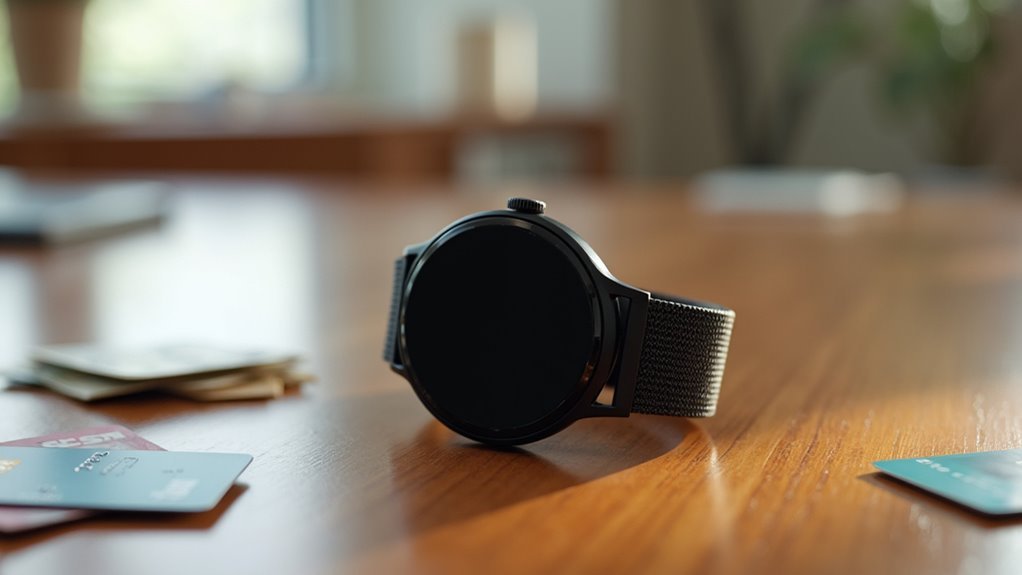
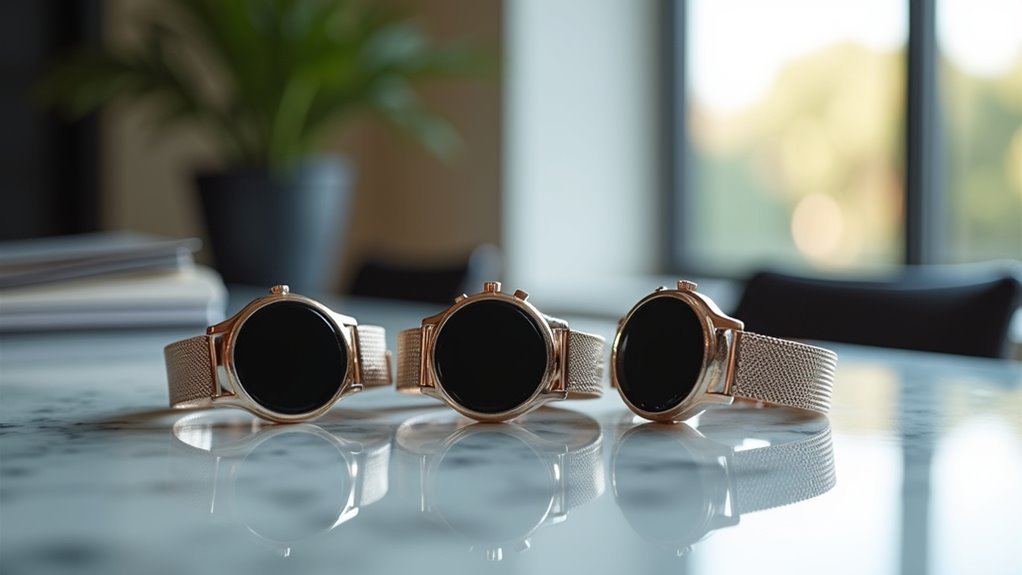
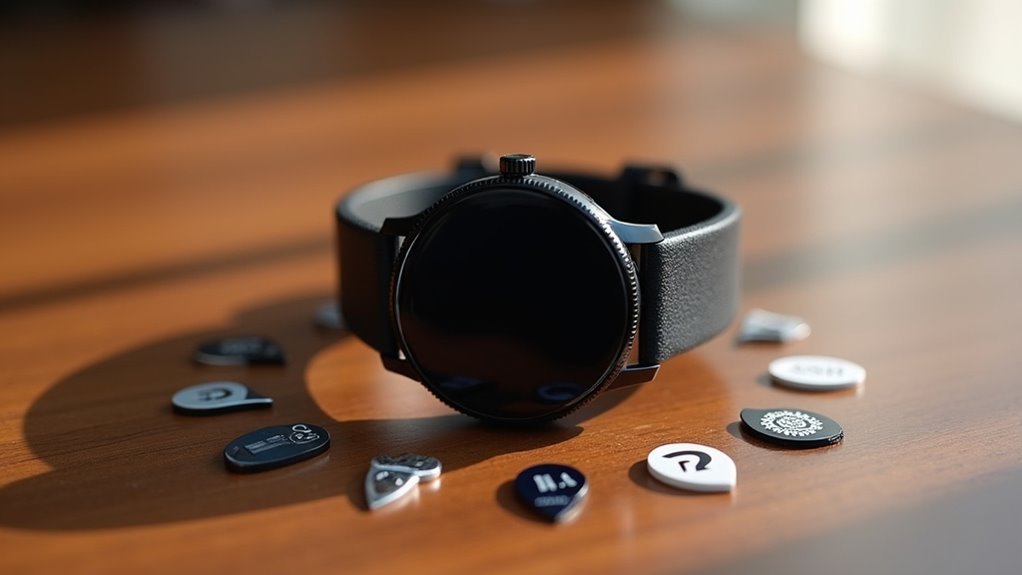
Leave a Reply